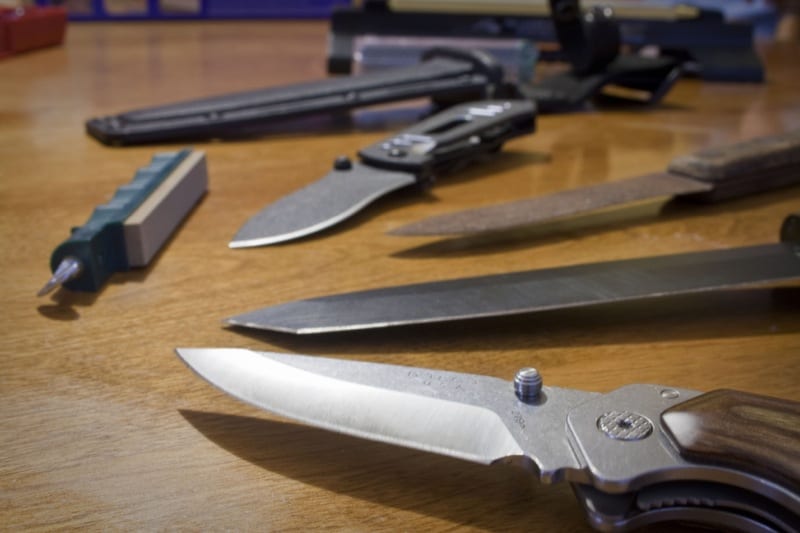I have to admit that this article arose out of a desire to finally understand how to choose the best knife sharpener when tackling the various EDC folding knives and kitchen knives used by our staff. Those are two very different applications, requiring very different types of knife sharpening. With tons of experience critically testing tools and a large array of experience with literally dozens of different pocket knives over the years, I have decades of combined experience to suss out the very best sharpeners for almost any application or user.
Our Top Knife Sharpener Picks
- Best Overall: Work Sharp Professional Precision
↓ Jump to this Sharpener - Best for the Money: Smith’s PP1 Pocket Pal
↓ Jump to this Sharpener - Easiest Knife Sharpener: Tumbler Starter Kit
↓ Jump to this Sharpener - Best Electric for Kitchen: Chef’sChoice 15XV Pro
↓ Jump to this Sharpener - Best Manual for Kitchen: Smith’s 50146 Stainless
↓ Jump to this Sharpener - Best for Scissors: Smith’s 50185 Jiffy-Pro
↓ Jump to this Sharpener - Best Whetstone: Intelitopia Complete
↓ Jump to this Sharpener
Best Knife Sharpener Overall

Work Sharp Professional Precision Adjust
- Model: WSBCHPAJ-PRO
- Grits: 6 + leather strop
- Angles supported: 15–30°
- Abrasive size: 1 in. x 6 in.
Having used the Lansky knife sharpening system for years, Work Sharp takes everything great about that system and improves it. While not inexpensive, the Work Sharp Professional Precision sharpener features metal construction. Of particular note, the articulating hinge point is metal—the part that arguably suffers the most abuse during use. You can adjust the system from 15 to 30 degrees using a simple adjustment knob. On top of that, Work Sharp gives you a digital angle finder for even better precision.
While Work Sharp also makes electric sharpeners like their Ken Onion Edition, I prefer the less aggressive manual sharpener as it produces a much better and much more consistent result. Note: If you want to risk plastic construction and a weaker hinge point, check out the Work Sharp Precision Adjust Knife Sharpener, which has many of the same core features but at a savings of nearly $200!
In the end, you get 220, 320, 400, 600, 800 (diamond), and fine ceramic abrasives along with a leather strop. The kit includes a metal sharpening frame, table attachment, digital angle indicator, seven sharpening abrasives, ceramic rod, leather strop, metal V-clamp, and clamp stabilizer.
Reasons to Buy
- Excellent construction
- Enough flexibility to sharpen nearly any knife (even serrated)
- Replaceable magnetic sharpening stones
Consider Another Model if You…
- Want something less expensive
- Need a less time-consuming setup and process
Verdict: The most flexible sharpening system that’s guaranteed to give you an excellent edge every time.
Best Knife Sharpener for the Money
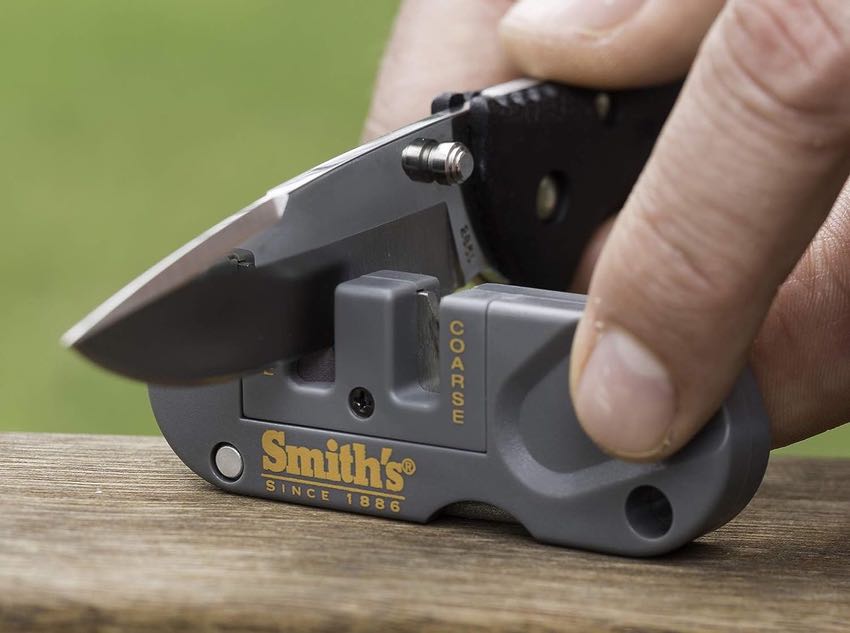
Smith’s PP1 Pocket Pal
- Model: PP1
- Grits: Coarse, ceramic + rod
- Angles supported: ~23°
- Style: 1-directional pull
You can find a lot of inexpensive solutions for portable knife sharpening. I tend to lean into those that work well for pocket knives as opposed to tabletop kitchen knife sharpeners. Smith’s PP1 Pocket Pal Knife Sharpener gives you a very simple, travel solution for sharpening even the dullest knives. I like the independent coarse/fine carbide/ceramic grooves as well as the fold-out diamond-coated rod for dealing with serrated blades. If you want something to take camping, leave it in your glove box, or just about anywhere you may run into a need to care for a dull blade.
I also love the design of this tool. Where some require you to (dangerously in our opinion) hold the sharpener in your hand, the flat bottom of the PP1 lets you sit it securely on a table while you pull away from the sharpener. Note: Pull-through sharpeners wreak havoc on the actual blade edge. Use a more expensive flat stone sharpening system for the best results and the long-term health of your blades.
Reasons to Buy
- Super-portable
- Tackles serrated blades
Consider Another Model if You…
- Need more than one angle option for sharpening your knives
Verdict: Take this $10 sharpening tool with you anywhere, but avoid using it on more expensive blades where you want a truly perfect edge.
Easiest Pocket Knife Sharpener to Use

Tumbler Rolling Knife Sharpener
- Model: Original Starter Kit
- Grits: D35, honing + strop
- Angles supported: 15°, 20°
- Style: 2-direction back/forth
The Tumbler’s design is both straightforward and ingenious. A magnetic block holds your knife at either a 20° or 15° angle while you roll the sharpener along the blade edge. The process is surprisingly simple.
One key difference between the Tumbler and other knife sharpeners I use is the absence of a coarse stone. Most sharpening systems include both a coarse and a fine stone to quickly restore the blade’s shape before creating a precise edge and finishing with honing.
The Tumbler rolling knife sharpener offers precision hand sharpening without having to manually maintain your blade’s angle against the sharpening stone. Having a high level of control over the sharpening technique outweighs the slower process other knife sharpeners might provide. If you use this sharpener regularly, it will keep your blade in tip-top shape.
Reasons to Buy
- Easiest to use sharpener by far
- Even wear across the diamond wheel
- Includes leather strop
Consider Another Model if You…
- Have a truly damaged blade to start with
- Need a razor blade sharp edge
- Require a different angle than 15 or 20°
Verdict: Using this system makes you feel like a Pro and is likely to have you regularly sharpening your knives due to its simplicity.
Best Electric Knife Sharpener for Kitchen Knives

Chef’sChoice Trizor 15XV Professional
- Model: 15XV
- Grits: Coarse, hone, polish
- Angles supported: 15°
- Style: 1-direction pull
- Noise: 65-75 dBA
If you want a much speedier method of sharpening all of your kitchen knives, the ChefsChoice Trizor 15XV Professional Electric Knife Sharpener does an amazing job. While certainly not as quiet as a manual sharpener, you gain the advantage of being able to cruise through sharpening a dozen knives in less than 15 minutes. The Trizor 15XV features a three-stage sharpening system (sharpen, hone, polish). It takes up just 10 inches of width on your counter—but I recommend storing it underneath in a cabinet and just pulling it out when you need to sharpen a knife or two.
What really makes this system stand out are the guides. The sharpener automatically guides your knife through the sharpening process. For those new to sharpening, this means you don’t have to develop a technique or hold the knife exactly at the perfect angle. The system automatically presses the blade against the plastic guide to hold the perfect angle. The course grind also has enough oomph to rehone your 20° blade to 15° if it has a slightly shallower grind to begin with. Another advantage of this system is that you can use the polish (third) slot for serrated blades.
Reasons to Buy
- Truly carefree sharpening
- Supports serrated blades
Consider Another Model if You…
- Want a more budget solution
- Don’t like a noisy sharpener
- Need to sharpen scissors
- Want a razor edge
Verdict: A truly quick and idiot-proof kitchen knife sharpener for anyone
Best Manual Knife Sharpener for Kitchen Knives
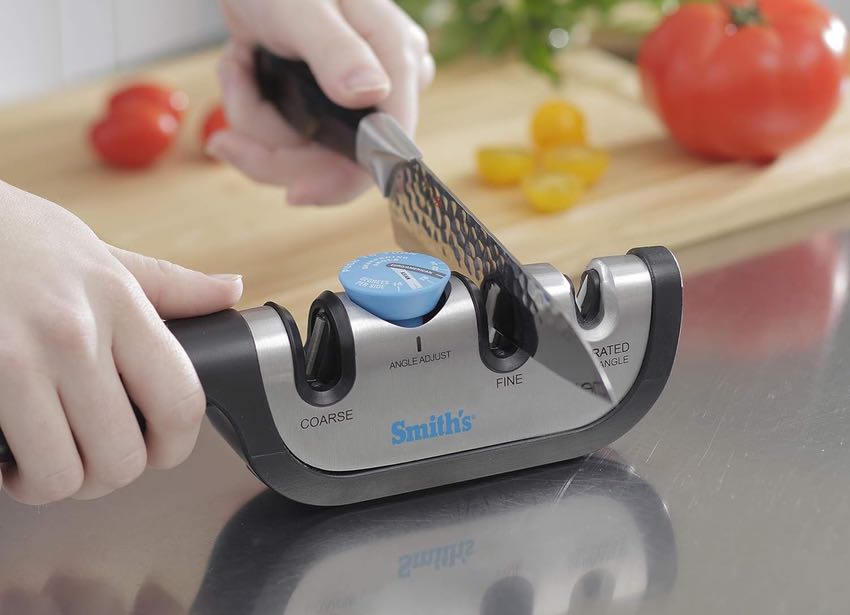
Smith’s 50146 Stainless Adjustable Angle
- Model: 50146
- Grits: Coarse, fine + serrated
- Angles supported: 14–24°
- Style: 1-direction pull
- Replaceable blades
With possibly the most helpful feature I’ve seen, the Smith’s 50146 Adjustable Angle Knife Sharpener gives you a way to dial in angles from 14 to 24 degrees. That makes it perfect for paring or chef’s knives. It even handles serrated blades with the help of a fixed blade. Smith’s makes a plastic version of this, but I prefer the stainless model.
Reasons to Buy
- Adjustable sharpening angle
- Stainless steel design
- Replaceable blades!
Consider Another Model if You…
- Want to sharpen more quickly
- Need something outside the angles provided
- Want a utility knife edge
Verdict: The only knife sharpener you need for your non-serrated kitchen knives
Best Knife Sharpener for Scissors
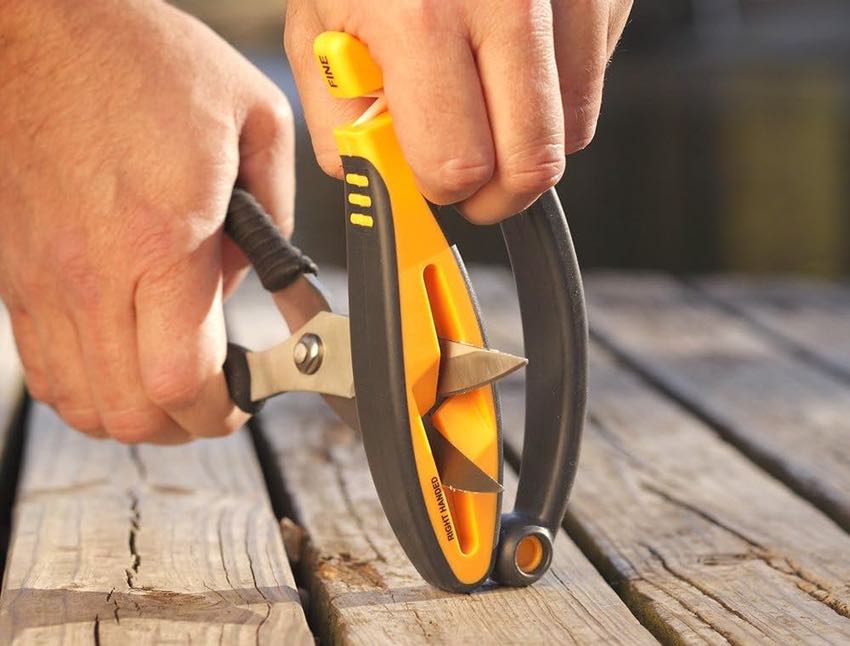
Smith’s 50185 Jiffy-Pro
- Model: 50185
- Grits: Coarse, fine + scissors
- Angles supported: 20°
- Style: 1-direction pull
- Left & right-handed scissors
Sometimes, you come across a solution that really excels at more than one task. That’s the case with the Smith’s 50185 Jiffy-Pro Handheld Sharpener. It has a nice ergonomic grip for fine ceramic sharpening, but the tool also lets you sharpen scissors more easily than most. Stand the tool upright, and you can insert a pair of scissors from either side, depending upon which blade you want to sharpen.
I don’t think it does the best job sharpening a truly dull blade, but in a pinch, it can get you back up and operating. For honing a reasonably sharp blade, however, it does very well.
Reasons to Buy
- All-in-one inexpensive solution
- Hones blades and sharpens scissors
Consider Another Model if You…
- Don’t like plastic construction
Verdict: Best for quickly honing or deburring blades of all types, plus sharpening scissors
Best Whetstone Knife Sharpener
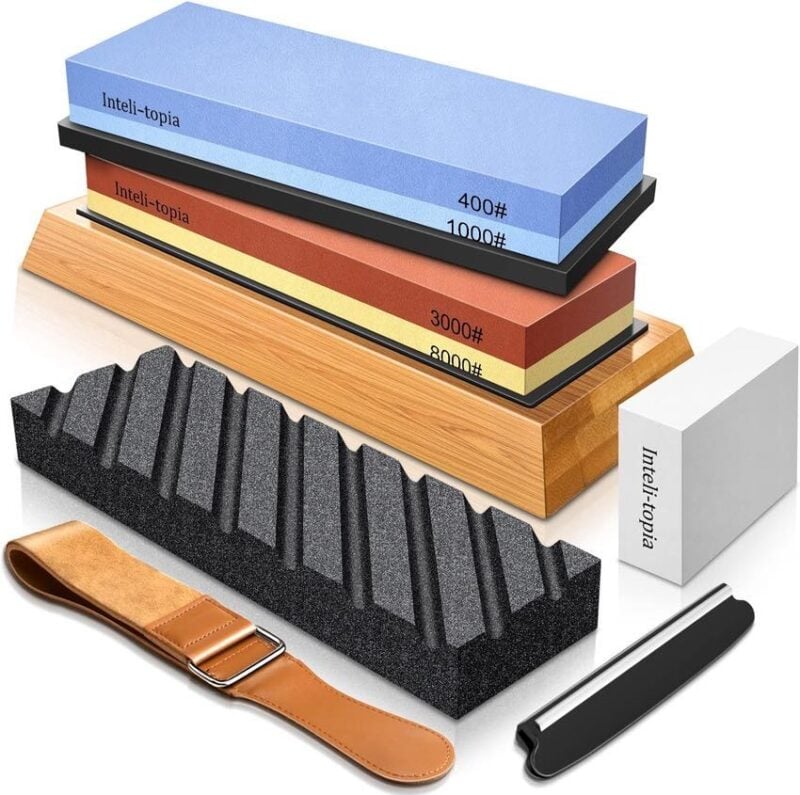
Intelitopia Complete Whetstone
- Model: MDS00A
- Grits: 400/1000 and 3000/8000
- Angles supported: Any
- Style: 2-direction pull/push
- Leather strop and angle guide included
You can choose to pay more for a DMT sharpening kit—and I used to—however, the Intelitopia Complete Whetstone Knife Sharpening Set includes everything you need for taking care of most non-serrated blades. I particularly like the dual-sided 400/1000 and 3000/8000 grit blocks coupled with the bamboo base. You also get a leather strop for finishing your edge as well as a course flattening stone to reset your aluminum oxide sharpening stones back to flat. Finally, for those who don’t know how to use a whetstone, you get a handy instruction manual that walks you through the entire process along with a handy angle guide.
Reasons to Buy
- Straightforward sharpening process
- Includes strop and angle guide
Consider Another Model if You…
- Prefer a method with less prep time (wetting stones)
- Want something with a more forced blade angle system
Verdict: My go-to sharpener for larger fixed-blade knives
Our Process and the Nitty Gritty
- Why You Can Trust Pro Tool Reviews
- How to Choose a Knife Sharpener
- How to Sharpen Serrated Blades
- Other Knife Sharpeners We Recommend
- Frequently Asked Questions
- Some Additional Thoughts
Why You Can Trust Pro Tool Reviews
Ever check out a “review” site and you can’t tell if they actually tested anything or if they’re just “recommending” the Amazon top sellers? That’s not us. We won’t recommend anything unless we’d use it ourselves, and we don’t care who the primary retailer is. It’s all about giving you a legitimate recommendation and our honest opinion of each product.
We’ve been in business since 2008, covering tools, writing reviews, and reporting on industry news in the construction and lawn care industries. Our Pro reviewers work in the trades and have the skills and experience to know whether tools can perform well in the field.
Each year, we bring in and review more than 350 individual products. Our team will put our hands on hundreds of additional tools at media events and trade shows throughout the year. Pro Tool Reviews consults with innovators in the technology and design of tools to gain a broader grasp of where these products fit and how they work.
We work with more than two dozen professional contractors around the United States who review products for us on real job sites. We consult with them extensively on testing methods, categories, and practical applications. The result is information you can trust because of the editorial, scientific, and real-world professional experience we collectively utilize each and every time we pick up and test a tool.
How to Choose a Knife Sharpener
When thinking about how to choose a knife sharpener, start with what kinds of knives you plan to sharpen. My recommendations differ between sharpening EDC folding knives vs honing kitchen knives. The desired application matters as does the metal composition of each blade.
In general, when sharpening very dull knives you want something specifically made to put a new or renewed edge on the blade. That entails either a good quality sharpening stone, diamond stone, or—at the very least—carbide blades. For the task of putting on a new edge, you also want to ensure you have a good level of consistency. If your system lets you vary the angle because it relies on your grip or hand position, you could end up working against yourself with every other stroke. Something with a solid angle guide should speed up the process.
If you tend to keep up with knife sharpening, then simply having a good-quality ceramic sharpener might be all that you need. A few passes regularly with that kind of system lets you maintain a nice edge for many years.
How to Sharpen Serrated Blades
Another consideration—aside from your budget, of course—is the sharpening of serrated blades. Not every sharpening system accommodates those blades—and not all serrated blades are the same. Whether you need a pull-through solution or a stone sharpening system, be certain your sharpener is designed to keep these blades in tip-top shape.
Serrated blade sharpeners come in several forms. Some feature a conical diamond sharpening tool that neatly fits the curvature of the serrated edge. Others utilize a ceramic groove to sharpen the smooth edge of a serrated blade.
In either case, not all sharpeners that claim to handle serrated blades work equally well. It helps to follow the manufacturer’s instructions to avoid ruining the fine tips and edges present on these knives.
Other Knife Sharpeners from Trusted Brands
Work Sharp Ken Onion Knife & Tool Sharpening System MK2
I enjoyed using the original Work Sharp Ken Onion Knife & Tool Sharpener Field Kit. While, by far, the quickest sharpening system of all the ones I’ve tested, it didn’t make my top list due to the learning curve and how much material it tends to take off the blade. You also have to go through a process to swap out the abrasive belts to go from one grit to another—a process that, while not difficult, slows down the process considerably. Lastly, by its nature, the Work Sharp puts a convex edge on your knives as opposed to the other systems I use that produce a flat grind.
The MK2 system has a new edge guide system and belt tracking system that makes it even easier to use.
- Pros: Supports 15–30 degree angles; fast sharpening
- Cons: Removes lots of material, creates a convex edge, requires belt changes
- Verdict: I love the sheer speed of sharpening this system affords
Specifications
- Model: WSKTS-KO2
- Grits: P120 Extra Coarse, X65 Coarse, X22 Medium, X4 Fine, 6000 Extra Fine
- Includes: Sharpener, 5 pc belt kit, adjustable guide, DVD, soft bag
DMT Deluxe Diamond Knife Sharpening 3-pc Kit
Made-in-the-USA DMT offers similar performance to my Intelitopia recommendation above but gives you diamond technology. No honing oil is needed. You can wet the stone or use it dry (I prefer soaking the stones first). The Deluxe kit includes Coarse, Fine, and Extra-Fine stones in a wooden box. This is a great sharpening system and an even better gift!
- Pros: Supports 15–30 degree angles; fast sharpening
- Cons: Removes lots of material, creates a convex edge, requires belt changes
- Verdict: I love the sheer speed of sharpening this system affords
Specifications
- Model: 20062
- Grits: P120 Extra Coarse, X65 Coarse, X22 Medium, X4 Fine, 6000 Extra Fine
- Includes: Sharpener, 5 pc belt kit, adjustable guide, DVD, soft bag
Frequently Asked Questions
Do Knife Sharpeners Really Work?
Absolutely! Regardless of what type of sharpener you use, you’ll quickly find that you can take an underperforming blade and make it as good as new. Factors that affect whether a blade sharpens well have more to do with the style of steel in the blade itself and whether or not you follow a proper technique when honing the blade. Also, keep in mind that the level of dullness on the blade should determine the grit or level of sharpening you should do when getting it back to pristine cutting condition.
If you truly value your blades and have an expensive knife, you want to favor a flat stone over a pull-through sharpener. The former delivers a smooth, perfect edge while the latter leaves rough edges when viewed through a microscope. Over time. a pull-through sharpener can continuously damage a blade’s edge. You can get a lot of life off a cheap kitchen knife using these types of sharpeners, but you may not want to do that with an expensive blade. In any case, you can always correct a blade’s edge by periodically giving it a more thorough sharpening with a flat stone system.
Which Knife Sharpener Works Best for Fillet Knives?
Fillet knives require a much steeper 15- to 20-degree blade angle. Asian-style knives tend toward 15 degrees with their American counterparts often manufactured to the 20-degree angle. In either case, you want to ensure your knife sharpener supports this shallower angle so that you can keep that nice filleting edge on your blade. Expect to sharpen these knives more frequently to ensure consistent performance.
What Knife Sharpener Does Gordan Ramsey Use?
We can’t speak to what sharpener he always uses, but if you look closely at a video posted to his Youtube account on December 17, 2013, he demonstrates his sharpening technique using what appears to be a Friedr Herder 12-inch 1/2″ Round Sharpening Steel. The current model for this can be found here and runs about $39 before shipping. As you can imagine, Gordan has really honed his technique over the past several decades (pun intended!)
Some Additional Thoughts
Knife sharpening is part craft, part technique, part efficiency, and part passion. When you add those up and tack on your own preferences, I’m certain you can choose something off this list and have great success. The bottom line? If you want to keep your knives sharp, lots of excellent systems exist to help you do that. What surprised me was just how affordable many of these solutions are. In the end, you may end up wanting to purchase more than one to take care of your personal knife collection.

